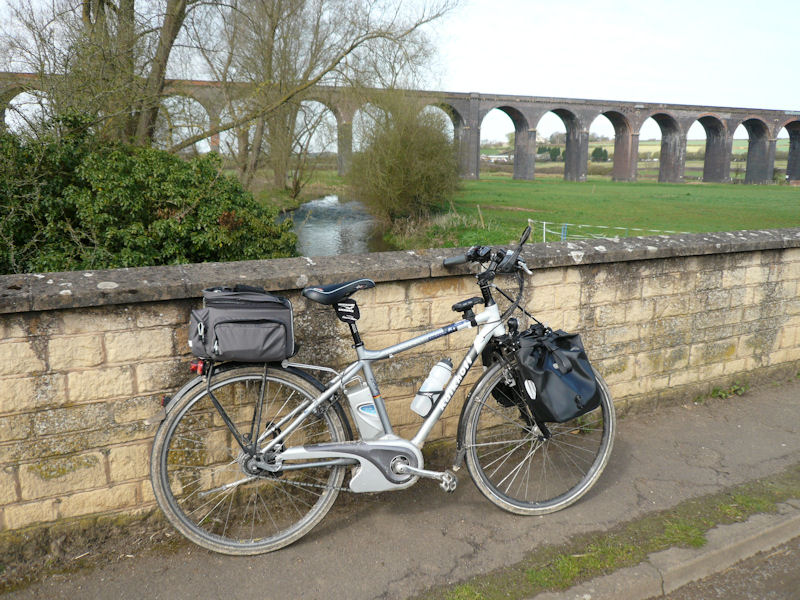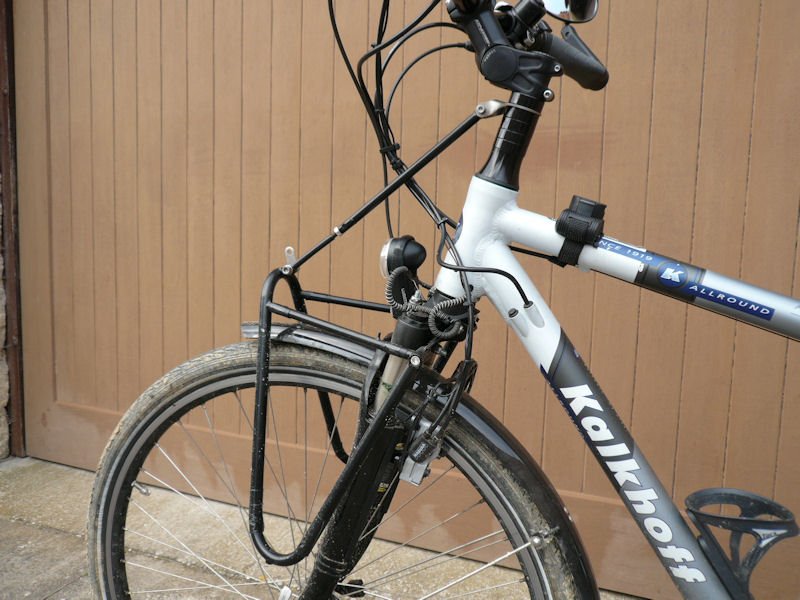Two lovely days of cycling in Rutland on Thursday and Friday last week.
This picture was taken beside the River Welland Viaduct, coming out of Harringworth towards Uppingham.

My Pro Connect will be 2 years old in June and it has had a number of changes along the way. Now retired, I enjoy touring with the bike, and have steadily been increasing the range of a day’s cycling.
The 8 speed Nexus SG-8R36 hub is fitted with a 19 tooth chain sprocket, which I find to be an excellent compromise between the original, low geared, 23 tooth sprocket and the highest available gearing afforded by a 16 tooth sprocket.
With this set up, coupled with highest level of assistance on constantly (motor contributes up to a maximum of 57% of the workload), I work on 20 miles per battery as a safe capacity guide, regardless of the severity of hills in the area.
Now that spring has arrived and the weather is warmer, typically, the 2 original batteries (approaching 2 years old) will enter the final stage of capacity with a flashing light on the handlebars at 19/20 miles, whilst a new battery purchased just 2 weeks ago, reaches this phase at 22/23 miles.
Using the batteries down to completely empty (approx 3 miles of flashing prior to cutout) is not recommended except when conditioning, and there is a noticeable reduction in assistance from the motor when the final phase of capacity is reached.
Previously riding with 1 additional battery in the Creek2Peak rack bag (smaller 16 litre size for the Pro Connect), I have been experimenting with carrying 2 on the front of the bike.
Pro Connect S suspension fork
The standard 2008 model of Pro Connect is fitted with very solid, unsprung, front forks which I found to be hard on the shoulders.
Raising the handlebars on the original forks with the Satori HeadsUp stem extender (shown below) helped considerably, but I finally decided to swap the forks to the Pro Connect S suspension forks at the end of last year.

Retaining the full length of the uncut steerer tube on the S forks gave me a similar height for the handlebars, coupled with the resilience of the suspension.
There has been debate in the forum previously relating to the stiffness of the S suspension forks, and in comparison to softer mountain bike forks, this is indeed true. But in comparison to solid forks, there is an immediate reduction in wear and tear on the shoulders for riding through potholes, cobbles and cycle tracks.
They would not be a good choice for significant offroad use.
Weight and Size of Additional Batteries
The Panasonic battery weighs 2.4 kg and, at 26 volt / 10 Ah, it is relatively compact compared with many of the higher rated batteries.
Nonetheless, carrying the weight of additional batteries on an unsprung bike is a noticeable shock through the frame when hitting a pothole etc.
With the standard battery position being at the rear of the bike, loading further batteries onto the rear carrier produces an unforgiving load which might be better distributed.
Tubus “Swing” Suspension Fork Carrier / Ortlieb Front Roller Classic bags
Unlike many models of low rider front carriers, the Tubus Swing mounts to the upper, sprung, part of the forks. Effectively this means that the load being carried is cushioned by the suspension.
The carrier mounts to the crown of the fork, and has a stay running down from the top of the steerer tube to the front edge of the carrier.

It can only be fitted to the Ahead type of stem as used on the Pro Connect, and is not suitable for the quill type of stem as used on Agattus and Tasmans.
The mounting plate along the backside of the crown of the fork would normally conflict with rim brakes mounted on the back of the fork (as on the Pro Connect), but I had opted to fit Magura HS11 hydraulic rim brakes. With careful attention to the Magura Brake Evo mounting plate, sufficient clearance can be achieved.

The carrier is exceptionally light in weight and handles the Ortlieb Front Roller Classic and similar bags.
The Panasonic batteries lie flat in the bottom of the Front Roller Classic bags, leaving substantial space above the battery for clothing etc. Designed for a payload of 15 kg, 2x batteries takes approximately half the payload of the Swing Carrier.
Riding Performance
This set up would not be appropriate for severe changes in direction that you might experience on narrow, windy paths.
On the open road and cycle tracks that are relatively straight, it is easy to get used to the additional inertia in the steering.
Recognising that the Pro Connect S forks are relatively stiff, the extra weight is not a problem and is maybe beneficial to the comfort experienced by the rider.
These notes might be of use to others who enjoy touring with their ebikes.
James
PS It was good to see another couple of ProConnect riders in the village of Barrowden.
This picture was taken beside the River Welland Viaduct, coming out of Harringworth towards Uppingham.

My Pro Connect will be 2 years old in June and it has had a number of changes along the way. Now retired, I enjoy touring with the bike, and have steadily been increasing the range of a day’s cycling.
The 8 speed Nexus SG-8R36 hub is fitted with a 19 tooth chain sprocket, which I find to be an excellent compromise between the original, low geared, 23 tooth sprocket and the highest available gearing afforded by a 16 tooth sprocket.
With this set up, coupled with highest level of assistance on constantly (motor contributes up to a maximum of 57% of the workload), I work on 20 miles per battery as a safe capacity guide, regardless of the severity of hills in the area.
Now that spring has arrived and the weather is warmer, typically, the 2 original batteries (approaching 2 years old) will enter the final stage of capacity with a flashing light on the handlebars at 19/20 miles, whilst a new battery purchased just 2 weeks ago, reaches this phase at 22/23 miles.
Using the batteries down to completely empty (approx 3 miles of flashing prior to cutout) is not recommended except when conditioning, and there is a noticeable reduction in assistance from the motor when the final phase of capacity is reached.
Previously riding with 1 additional battery in the Creek2Peak rack bag (smaller 16 litre size for the Pro Connect), I have been experimenting with carrying 2 on the front of the bike.
Pro Connect S suspension fork
The standard 2008 model of Pro Connect is fitted with very solid, unsprung, front forks which I found to be hard on the shoulders.
Raising the handlebars on the original forks with the Satori HeadsUp stem extender (shown below) helped considerably, but I finally decided to swap the forks to the Pro Connect S suspension forks at the end of last year.

Retaining the full length of the uncut steerer tube on the S forks gave me a similar height for the handlebars, coupled with the resilience of the suspension.
There has been debate in the forum previously relating to the stiffness of the S suspension forks, and in comparison to softer mountain bike forks, this is indeed true. But in comparison to solid forks, there is an immediate reduction in wear and tear on the shoulders for riding through potholes, cobbles and cycle tracks.
They would not be a good choice for significant offroad use.
Weight and Size of Additional Batteries
The Panasonic battery weighs 2.4 kg and, at 26 volt / 10 Ah, it is relatively compact compared with many of the higher rated batteries.
Nonetheless, carrying the weight of additional batteries on an unsprung bike is a noticeable shock through the frame when hitting a pothole etc.
With the standard battery position being at the rear of the bike, loading further batteries onto the rear carrier produces an unforgiving load which might be better distributed.
Tubus “Swing” Suspension Fork Carrier / Ortlieb Front Roller Classic bags
Unlike many models of low rider front carriers, the Tubus Swing mounts to the upper, sprung, part of the forks. Effectively this means that the load being carried is cushioned by the suspension.
The carrier mounts to the crown of the fork, and has a stay running down from the top of the steerer tube to the front edge of the carrier.

It can only be fitted to the Ahead type of stem as used on the Pro Connect, and is not suitable for the quill type of stem as used on Agattus and Tasmans.
The mounting plate along the backside of the crown of the fork would normally conflict with rim brakes mounted on the back of the fork (as on the Pro Connect), but I had opted to fit Magura HS11 hydraulic rim brakes. With careful attention to the Magura Brake Evo mounting plate, sufficient clearance can be achieved.

The carrier is exceptionally light in weight and handles the Ortlieb Front Roller Classic and similar bags.
The Panasonic batteries lie flat in the bottom of the Front Roller Classic bags, leaving substantial space above the battery for clothing etc. Designed for a payload of 15 kg, 2x batteries takes approximately half the payload of the Swing Carrier.
Riding Performance
This set up would not be appropriate for severe changes in direction that you might experience on narrow, windy paths.
On the open road and cycle tracks that are relatively straight, it is easy to get used to the additional inertia in the steering.
Recognising that the Pro Connect S forks are relatively stiff, the extra weight is not a problem and is maybe beneficial to the comfort experienced by the rider.
These notes might be of use to others who enjoy touring with their ebikes.
James
PS It was good to see another couple of ProConnect riders in the village of Barrowden.
Last edited:







